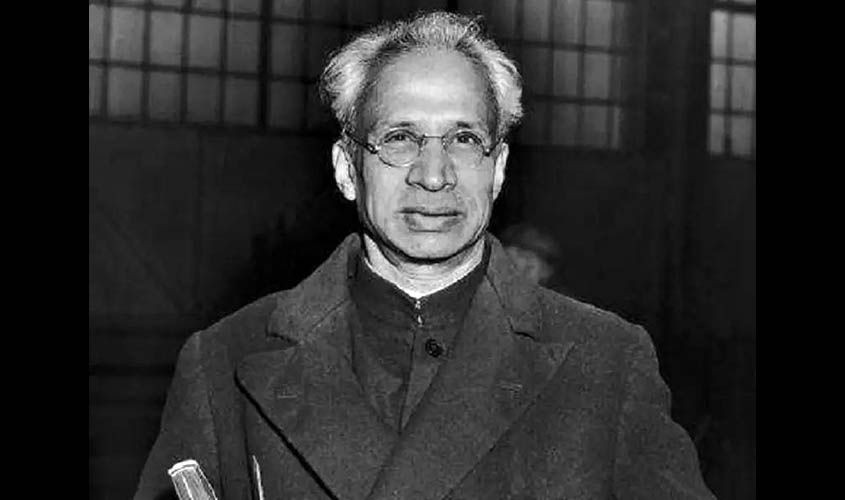After shaking hands with the almighty Mao, he flouted every rule of protocol. The Chairman was taken aback.
Before leaving for Peking in July 1956, to join our embassy, I went to see Dr S. Gopal (the son of Vice-President Dr S. Radhakrishnan), at the time director of the Historical Division of the Ministry of External Affairs. I asked him to recommend some books on China that I should read before embarking on my passage to China. One of these was, Red Star over China by Edgar Snow, first published in 1937. Snow was the first foreign newspaperman to interview Mao Tse Tung. Consequently, Edgar Snow’s book became a world bestseller.
In the autumn of 1957, Dr Radhakrishnan paid an official visit to China. I was present at his meeting with Chairman Mao Tse Tung. After shaking hands with the almighty Mao, the Vice-President flouted every rule of protocol. He patted Mao on his right cheek. The Chairman was taken aback. All present froze. Dr Radhkrishanan uttered 12 words which melted the tension. “Mr Chairman, don’t be alarmed. I did the same thing to Stalin.”
The Vice-President was shown great courtesy and respect. The scholars in China were familiar with his writings. The visit was, by all accounts, a success.
Three years later in April 1960, Prime Minister Chou En Lai came to New Delhi to hold talks with Prime Minister Jawaharlal Nehru on the Sino-Indian border dispute. He called on the Vice-President. The meeting ended on a sour note. The Vice-President misjudged the frame of mind of his formidable callers. Chou En Lai was accompanied by his Foreign Minister, Marshal Chen Yi. While Chou En Lai was one of the 20th century’s greatest diplomats, his Foreign Minister was not.
The Vice-President began on the wrong note. He was philosophising, “The Sino-Indian dispute should be settled during Nehru’s lifetime.” The Chinese leaders looked at each other, slightly puzzled. If I remember rightly, Chou En Lai said this was his fourth visit to India; Mr Nehru had been to China only once since the People’s Republic was established (not his exact words). He added that China too wanted an early and satisfactory resolution of the dispute. The Vice-President then said that war was not a solution and should at all cost be avoided. Marshal Chen Yi, bluntly said, he knew what war was. For 30 years he had fought Chiang-Kai-Shek and the Japanese. China too wished for an amicable solution. His country wanted friendly relations with India. The Vice-President reciprocated, but he unwisely added, “What are few square miles of territory, compared to the friendship of 400 million Indians?” To this the irrepressible Chen Yi said, “What are a few square miles of territory compared to the friendship of 600 million Chinese?”
The Nehru-Chou talks failed. The rest is melancholy history.
My admiration and reverence for Dr Radhakrishnan remained unabated. He treated me with affection and a certain amount of avuncular indulgence. This was mainly due to my close friendship with his son Gopal. He had an infectious effervescence. Which added to his structural charm. He was one of our outstanding historians. He wrote superb, elegant and stylish English. His three-volume biography of Jawaharlal Nehru is the best ever written on him. It is somewhat hagiography. My favourite Gopal book is the biography of his father—brilliant and candid deserving magna cum laude.
In his biography he writes about his father’s parenthood. “…More important is the doubt whether Veeraswami was his father. Parental responsibility lay, according to village rumour, with an itinerant Vaishnavite official. Sitamma’s brother, who served in the local administration, was thought to have arranged the rendezvous to oblige a superior officer. Credence is lent to the story by the difficulty in believing that Radhakrishnan and his four brothers and sisters belonged to the same genetic pool. Intellectual endowment and physical appearance both suggested that Radhakrishnan himself accepted this version and critical of his mother’s conduct, always, throughout his life, kept het at a distance. But he was attached to the man passed for his father.”
S. Gopal died in 2002 at the age of 79. I last met him in Chennai in 2000. In 2013, his collection of essays was published. It is edited by Srinath Raghavan, who authored, Strategic History of the Nehru Years.

